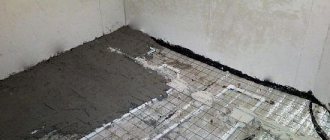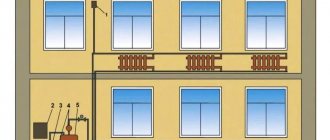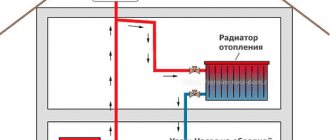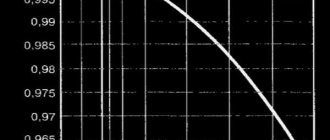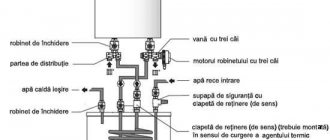The general principle of operation of all water heating systems is the same: the coolant is heated in the boiler and moves through the pipes to the radiators, transfers heat to the room, and then returns to the boiler. In this case, circulation can be natural or forced. It all depends on what sets the coolant in motion. In the first case it is gravity, in the second it is a pump.
General information about the two-pipe heating system
Any heating system with a liquid coolant consists of one or more closed circuits connecting radiators and a boiler.
In a two-pipe distribution, hot coolant is supplied through one branch of the circuit and returned through the other, hence the name.
Diagram of a typical two-pipe heating system in a private house.
Classification signs:
- The organization of coolant movement is gravity and forced.
- Design – open or closed, horizontal or vertical.
- Pipe routing – radial, dead-end, ring.
By combining properties, you can achieve the best suitability for operating conditions.
Connection diagrams for heating devices
Rice. 16. Some diagrams for connecting heating devices
Rice. 17. Wiring for radiators of the heating system
Rice. 18. Wiring diagram for a cast iron radiator
Rice. 19. Installation diagram of cast iron radiators
Advantages and disadvantages
The pros and cons of a two-pipe system should be considered taking into account the operational properties and technical characteristics.
| Advantages | Flaws |
| Same coolant temperature in all radiators | Increased pipe consumption - 2 branches need to be led to the radiator, inlet and outlet |
| Adjusting the heat output of each battery | Large diameter riser pipes and supply pipes to the first radiators in the circuit |
| Low hydraulic resistance | |
| Operation of the entire system in case of failure of one or more radiators | |
| Use in high-rise buildings | |
| Flexibility of hose options – in the floor, in the walls, along the walls, under the ceiling and behind a false ceiling |
The table shows common to all two-pipe networks. However, each wiring option may have negative qualities that limit its use, which we will consider later.
How a single-pipe heating system works: we explain it in diagrams
Installation methods
Let's touch on methods for installing heat-carrying communications. There is no clear opinion on this issue, so it is better to contact a company that installs heating systems for advice. The most common installation options are a single-pipe or two-pipe heating communications system. We will not dwell on them, but will tell you about two lesser-known methods.
Collector system
The main unit with this installation method in this system is the collector, which is responsible for the distribution of the coolant.
Manifold for a single-pipe heating system Source termoresurs.ru
Schemes of open and closed two-pipe heating systems
Coolant circulation is carried out in three ways:
- gravity (gravity);
- forced using a pump;
- combined.
In addition, systems are divided into open and closed. This indicator characterizes the interaction of the coolant and the atmosphere.
When heated, the volume of any coolant liquid increases. It is known that liquid is practically uncompressible, so to accommodate the “excess” a separate device is required - an expansion tank.
Open type
Scheme of a two-pipe open-type heating system.
In open systems, the tank is installed at the highest point, it is connected to the atmosphere by a pipe.
The advantages of an open system are simplicity and a minimum of additional devices. Any type of expansion tank can be used as an expansion tank.
.
Ready-made expansion tank for open-type CO.
Add water to the tank as needed. For this:
- install taps and connect the system to the water supply;
- add coolant through the opening hatch.
Attention! An open system must not be filled with antifreeze - evaporated gases can be toxic.
Closed type
In closed systems, a sealed expansion tank with an elastic diaphragm or balloon membrane inside is used. The membrane divides the device into 2 parts. Air is pumped into one chamber with a pump at a pressure of 1.2–1.5 atm, and the second is connected to the heating system pipe.
When the coolant heats up and expands, its excess fills the tank. When the temperature of the liquid drops, the membrane squeezes the coolant into the system. Preliminary injection of air into the tank allows you to maintain the pressure necessary for the operation of the boiler, the automation of which turns off the power at a pressure of less than 1.2 atm.
Antifreeze or glycols can be used in sealed structures.
Scheme of a two-pipe closed-type heating system.
In closed networks, the tank is located close to the boiler, which simplifies monitoring the performance of the entire structure.
Gravity flow schemes
Gravity (gravity) systems work due to the laws of physics. At normal atmospheric pressure, being heated to 50°C, water has a density of 988 kg/m3, and at 85°C - 968 kg/m3.
Scheme of a two-pipe open-type gravity system.
In the heating circuit, hot water (lighter) rises through the pipes, and the coolant cooled in the radiators moves down, returning to the boiler through the “return”. The circulation pump is not used.
Advantages of gravity systems:
- rare cases of airing - low coolant speed slowly squeezes air into the expansion tank;
- long service life due to the absence of a circulation pump and a membrane expansion tank, which have a limited resource;
- use of cheap coolant (water) - in case of leaks, you don’t have to buy antifreeze;
- self-regulation - when the air temperature in the building decreases, the water in the system cools faster, which increases the circulation rate, increasing the temperature in the rooms.
Independence from electricity allows you to operate the system in country houses where the power supply is often cut off, as well as install solid fuel boilers - when the circulation pump is turned off, the boiler will not boil or explode.
Gravity-flow systems also have a number of disadvantages:
- low pressure drop forces the use of large diameter pipes (up to 75-100 mm) in risers and up to 50 mm in supply branches;
- maximum contour length – 30 m;
- long warm-up after switching on, caused by the slow movement of the coolant;
- pipelines are laid at an angle to the horizon, and the expansion tank cannot be moved outside the heated room, which affects the attractiveness of the interior;
- not suitable for buildings above 3 floors.
As a result, gravity systems are preferable:
- in areas with interruptions in power supply;
- for rooms where the appearance of the structure is not important;
- for country houses no higher than 7-9 meters;
- for solid fuel boilers (coal, firewood, briquettes), which cannot be stopped instantly during a power outage.
Bypass with circulation pump.
Some of the shortcomings are eliminated by installing a bypass with a pump into the gap in the supply pipe. In normal mode, the coolant is pumped into the system by a circulation pump; when the electricity is turned off, the flow is directed through an open pipe by gravity.
Forced circulation circuits
(Repeat).
In a system with forced circulation, the same scheme of a two-pipe closed-type heating system can be used. In systems with forced circulation, a pump must be installed: as part of the boiler or remotely. Installation is carried out in front of the boiler in the return pipe, where the coolant temperature is minimal.
The pump gives the circuit advantages:
- Radiators warm up quickly, as the coolant speed increases;
- powerful pumps allow you to create large circuits;
- all radiators have approximately the same temperature;
- in closed systems it is permissible to use antifreeze, which will not freeze and will not rupture the system during prolonged shutdowns;
- pipelines do not require slopes;
- pipes of smaller diameter are used, which reduces costs.
Flaws:
- frequent cases of airing due to the rapid speed of coolant movement;
- Volatility - you will need to install powerful autonomous power supplies;
- high price of powerful and in-boiler pumps.
Attention! For systems with solid fuel boilers, an uninterruptible power supply must be provided. The boiler cannot be stopped quickly and in the absence of circulation the coolant overheats, boils and the heat exchanger explodes.
Preferred Use:
- large buildings with extended heating circuits;
- an area with high-quality electricity supply or houses with electricity backup.
Most modern types of dual-circuit systems use forced circulation.
Types of pipe routing and heating systems construction
The types of heating system are determined by the spatial placement of radiators and pipes.
There are different layout schemes:
- horizontal or vertical;
- upper or lower wiring;
- with direct and reverse flow of coolant;
- pipe distribution to radiators - dead-end, radial, ring.
Each type and their combinations have quality characteristics that determine the choice depending on operating conditions.
Top or bottom wiring
Scheme of a two-pipe heating system with overhead wiring.
The upper distribution can be arranged in systems with gravitational and forced circulation, as well as in their combined version. The hot coolant is supplied through the central riser into the upper horizontal pipe from which it is distributed among the risers. The pipes are located under the ceiling of the upper floor.
| Advantages | Flaws |
| The difference in pressure allows the use of a large number of radiators | The pipes give off some of the heat in the upper part of the room, which reduces efficiency |
| Suitable for various construction schemes | Requires large diameter wiring, which is more expensive |
| Low hydraulic resistance | The appearance is not suitable for some interiors |
| Possibility of installing thermostats on each radiator or riser | Sometimes the expansion tank will have to be taken out into an unheated attic and high-quality insulation carried out |
| Low network pressure (up to 3-4 atm) is suitable for all types of radiators, including aluminum | Additional equipment will be required to install heated floors. |
The diameter of the pipes and the length of the circuits increases the volume of coolant, for pumping which powerful pumps are purchased.
Scheme of a two-pipe heating system with bottom wiring.
Systems with bottom wiring are distinguished by the location of the supply pipe and return pipe below the level of the radiators.
Mostly such schemes are used in systems with forced circulation.
Advantages of lower wiring:
- pipelines can be hidden in the floor or walls;
- there is no need to make a common riser, which allows you to organize heating for the first floor built, and equip the second and subsequent floors as needed;
- By installing collectors, you can organize a “warm floor” system.
An example of a collector unit that distributes coolant along the contours of a “warm floor”.
Among the disadvantages, users note frequent airing, and installers note difficulties with initial setup and balancing.
Vertical and horizontal wiring
Scheme of horizontal and vertical distribution of two-pipe CO.
The horizontal and vertical schemes differ in the presence of a main riser.
Vertical types are mainly used in multi-story buildings. The horizontal view is suitable for buildings of any number of storeys; when arranging, the design is taken into account and a pump of the required power is selected.
Designers and installers distinguish between several basic diagrams for pipe routing in heating systems.
Three basic diagrams of pipe routing.
The dead-end circuit is installed in most country houses and has another name - with reverse (counter) movement of the coolant. Supply and discharge pipes are connected to each radiator. Circulation is carried out by a pump. The main advantage of the system is that the coolant reaches all radiators at the same temperature, and with the help of regulators it is possible to maintain the required microclimate in each room.
Flaws:
- a large number of welded and coupling connections;
- a professional hydraulic calculation is required if there are more than 3 radiators in one circuit;
- There is often noise from moving coolant.
A Tichelman loop or a scheme with a parallel movement of the coolant is used in the lower horizontal distribution and allows you to hide the pipes under the floor covering or in the screed. According to reviews from installers, the associated scheme requires minimal configuration. The Tichelman loop works great with a large number of radiators, but will require an increased pipe diameter.
When installing radial distribution, collectors are used that are installed on each floor of the building.
Diagram of radial wiring of two-pipe CO to radiators with bottom connection.
The circuit feeds each radiator separately and allows the installation of a “warm floor” system. An important disadvantage is the high cost of purchasing pipes.
Source documentation
When designing heating, Energy-Systems is guided by the technical specifications received from the Customer, as well as regulatory and industry documentation (standards, codes of practice, technical regulations, etc.). Regardless of the type of fuel used, the method of heat transfer to the environment and other nuances, to carry out heat and power calculations we will need the following documents:
This documentation is necessary to calculate the heat loss of the facility, determine the required power of the heat and power system and select the optimal option. If you are having difficulty completing technical specifications for heating design, please use the feedback: our company’s specialists will provide you with consulting assistance in collecting initial data for the design of thermal power plants.
Prices
Without a detailed study of the client's task and familiarization with the object, we cannot announce the exact cost of design services, however, we can provide you with approximate prices for design work; our prices are indicated in the price list below.
Here you can calculate the cost of heating design.
What type of wiring to choose
The choice of construction scheme depends on the expected operating conditions:
- In buildings above 2 floors, heating is installed with main risers in a vertical pattern.
- In areas with frequent or prolonged power outages, preference is given to gravity systems with non-volatile boilers.
- For large objects, systems with forced circulation are installed, built using a horizontal type of wiring. The most suitable scheme in is the Tichelman loop.
- For independent execution, inexperienced users choose a dead-end wiring with several arms.
- When pouring pipes into the floor, it is advisable to choose a radial scheme with collectors on each floor - in the event of an emergency pipe rupture, you can turn off 1 radiator, postponing costly repairs with opening the floors.
- Small country houses, bathhouses and utility rooms are equipped according to a dead-end scheme.
Each specific case must be considered individually, taking into account the advantages and disadvantages of the types and types of heating systems.
Hydraulic calculation of a two-pipe heating system
The purpose of the hydraulic calculation is to determine the minimum required pipe diameter already at the design stage and select (if necessary) a circulation pump of sufficient power.
The general sequence boils down to the following steps:
- Calculation of the required power of radiators and construction of a general heat balance diagram.
- Determination of coolant flow in each arm of the circuit.
- Calculation of pipeline diameters.
- Selecting the required pump performance.
Only specialists with thermal engineering education can make accurate calculations, and we recommend contacting a specialized organization.
For most craftsmen who want to independently equip the heating system of a small house , you can limit yourself to an approximate calculation and include a 10-15% reserve for the power of the batteries, boiler, pipe diameter and pump performance.
Determination of the minimum required power
To accurately calculate the thermal power of radiators (and, accordingly, the boiler), you can use a calculator.
Houses made from standard building materials and with high-quality insulation will require 1.5-2 kW of radiator thermal power per 10 m2 of area in the northern regions, 1-1.5 in the middle zone and 0.6-1 kW in the southern regions.
The calculation is done for each room, and then all the indicators are added up. The data is plotted on a single diagram for further calculations.
Coolant flow
The amount of coolant required per unit time is calculated for each arm of the circuit.
To do this, use the formula: G=860* q/ ΔT , where
- G—coolant flow rate kg/h;
- q is the thermal power of radiators in the calculated area (kW);
- ΔT is the difference in coolant temperature at the inlet and outlet of the radiator, usually taken to be 20 °C.
For example, for a branch with a total radiator power of 3 kW and a coolant in the form of water, a flow rate of 860 * 3/20 = 129 kg/hour will be required.
For further calculations, the result is converted into data for water at a temperature of 60°C (the most common parameter in individual houses).
Use the formula: GV = G /3600ρ , where
- GV - water flow, measured in l/sec;
- ρ is the density of water at 60°C.
Result: 129/3600*0.983=0.035 l/sec.
Next, you need to find the resulting value in the hydraulic calculation tables for pipes; they can be found on the websites of pipe manufacturers.
An example of such a table.
For our example, a pipe with an internal diameter of at least 16 mm will be sufficient.
Important! Steel pipes are marked with the outer diameter, polypropylene pipes with the inner diameter.
Calculations are carried out separately for each circuit and displayed on the diagram. By adding up the flow rate by section, a general indicator is obtained, which is taken into account when choosing riser pipes and a circulation pump.

